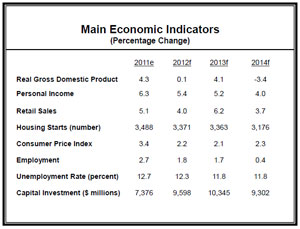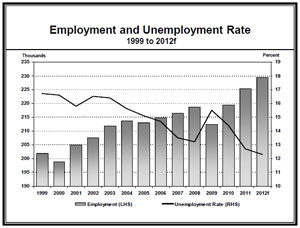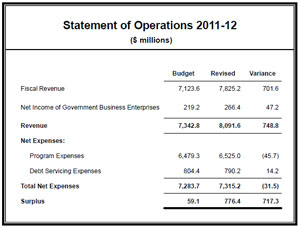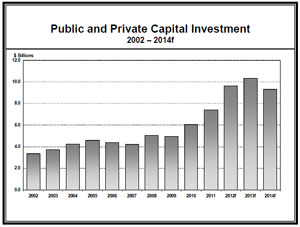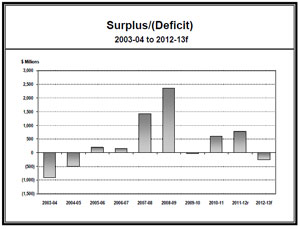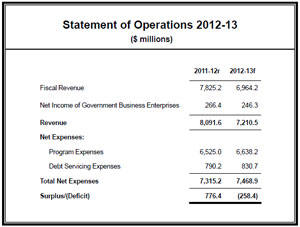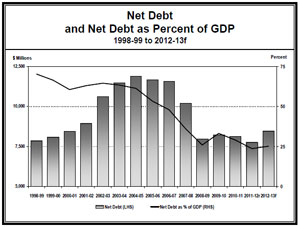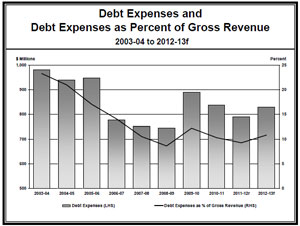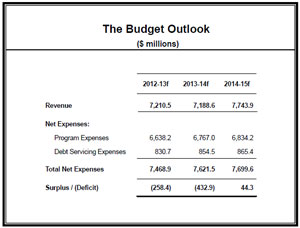- Home
- Budget Speech
Budget Speech
- Download Budget Speech
 (711 KB)
(711 KB) - Download Statements and Exhibits
 (681 KB)
(681 KB)
Table of Contents
- Introduction
- Economic Performance 2011
- Fiscal Review 2011-12
- Economic Outlook 2012
- Fiscal Forecast 2012-13
- People and Prosperity
- Sustainability and Renewability
Introduction
In October of last year, Mr. Speaker, the people of this province entrusted our government with a third mandate to build, with new energy, on the work we started – to raise Newfoundland and Labrador to the full measure of its magnificent potential.
That our province has undergone a wholesale transformation since 2003 is indisputable. Our newfound status as a leader on the national stage is unprecedented. How far we have come, and we have only just begun.
This year's Budget is about moving boldly forward, raising the pillars of new growth on that solid foundation, making responsible investments to deliver more fully the dividends of growth to the people of Newfoundland and Labrador.
Where once we dared only to dream, we now dare to believe. We have ditched once and for all the old defeatist stereotypes, the old self-deprecation, the old self-doubts that held us back from becoming all we were capable of being.
As our Premier stated in a business address in January: “Instead of wasting our time lamenting opportunities missed in generations past, we have set our gaze firmly on the opportunities before us now, determined to capture them to build a sustainable future.”
The plan I lay before you today follows through on the three principal objectives of this year's Speech from the Throne.
- It improves the delivery of services to the people who need them.
- It empowers businesses and communities to grow.
- It positions Newfoundlanders and Labradorians to seize career opportunities opening up all around them.
Our plan is fiscally responsible. It is socially progressive. It is carefully crafted to sustain the momentum that has made Newfoundland and Labrador an inspiration and an example to all Canadians of how it is done.
As far as we have advanced already, Mr. Speaker, the best is truly yet to come.
Economic Performance 2011
Let us begin by measuring how far we have progressed in the past year alone – a year in which many others have not fared so well.
Newfoundland and Labrador is predominantly an exporting province and, as such, we must consider the global economic environment in which we operate. The state of the global economy in 2011 could best be described as recovering but fragile. While GDP and employment growth were recorded in most countries, this growth was not as robust as would normally be expected after a deep recession, and concerns remain about the strength and sustainability of the recovery. European debt troubles continued to cause uncertainty, and GDP growth in China and India showed signs of slowing towards the end of 2011. On the other hand, the recovery in the United States showed some resilience towards the end of 2011, with quarterly GDP growth climbing to 3.0% in the fourth quarter.
Canada's economy fared better than those of the U.S. and most European nations in 2011, benefitting from strong commodity demand from developing countries like China and India. Newfoundland and Labrador continues to benefit from this strength in commodity demand and robust prices.
Economic growth was very strong in Newfoundland and Labrador in 2011. Real GDP is estimated to have grown by 4.3%, driven mainly by gains in investment and mineral production. This level of growth was one of the highest among the provinces last year.
Investment increased by 21.9% to $7.4 billion. Major projects continued to be drivers of investment spending as Vale's Long Harbour nickel processing facility, Hebron, White Rose and Hibernia expansions, and iron ore expansion in western Labrador proceeded throughout the year. Construction employment in 2011 was the highest ever recorded.
Exports received a boost from the continuing global economic recovery. Real exports are estimated to have grown by 2.0%. Offshore oil production decreased by 3.4% to a total of 97.3 million barrels, due to production issues at Terra Nova and natural declines. The volume of fish landed was down 12.1% compared with 2010, although higher prices for crab and shrimp resulted in a significant increase in value. Mineral shipments grew by 22% to about $4.6 billion, reflecting higher production and prices. This represented the highest mineral shipment value on record.
Employment grew by 2.7% to reach 225,400 in 2011, an all-time high. Newfoundland and Labrador recorded one of the strongest growth rates in employment in the country. The unemployment rate averaged 12.7% in 2011, 1.7 percentage points lower than in 2010 and in fact, Mr. Speaker, Newfoundland and Labrador last year enjoyed its lowest annual unemployment rate in 36 years.
Personal and disposable income both increased by 6.3% during the year.
Retail sales rose by 5.1% in 2011. Higher sales were supported by continued growth in income and high levels of consumer confidence, the highest in Atlantic Canada.
Population levels also benefitted from this economic performance. In February 2012, Statistics Canada released the results from the 2011 Census which indicated that since 2006, the population of the province increased by 1.8%.
Fiscal Review 2011-12
A year ago, in Budget 2011, we forecast a surplus of $59.1 million for the year ended March 31, 2012. Since Budget 2011, commodity prices have strengthened and, more significantly, offshore oil production increased by approximately 15.7 million barrels over our budget expectations, resulting in a projected surplus for 2011-12 of $776.4 million and a reduction in net debt of $361 million. Consistent with our Blue Book commitment, we will invest the equivalent of a third of the surplus to fund our public service pension plans.
Mr. Speaker, including the revised forecast for fiscal 2011-12, the cumulative value of surpluses generated in six of the last seven years approximates $5.5 billion, bringing the province's net debt to $7.8 billion at the end of fiscal 2011-12. I will have more to say about debt in a moment.
Economic Outlook 2012
But first, let us consider the economic outlook for the year before us.
The uncertainties that have persisted in the global economy in recent years are expected to continue in 2012. Sovereign debt troubles in Europe will act as a drag on global economic growth and there remains a distinct possibility of a mild European recession. Growth in developing economies like China and India is also expected to slow to more long-term stable levels.
In Newfoundland and Labrador, the underlying strength in the economy is expected to continue.
Real GDP is expected to increase by a modest 0.1% as the Terra Nova and White Rose production facilities are taken offline for maintenance. Nevertheless, most other economic indicators are expected to remain strong, reflecting higher levels of investment and overall strength in the economy.
Capital investment is expected to rise by 30.1% to an unprecedented $9.6 billion, representing the strongest investment growth in the country. The province will benefit from private sector investments, such as mining expansion in Labrador West. Construction activity on Vale's nickel processing facility is expected to peak this year. Development of the Hebron oil field will continue to advance with construction of the GBS and topside modules scheduled to commence this year, and the Muskrat Falls Project will continue to move towards a project sanction decision. As well, Government's commitment to road work and other public infrastructure in the coming year will be a major contributor to investment activity.
Employment is expected to grow by 1.8% to an average of 229,400 and the unemployment rate is expected to drop further to 12.3%. Personal income and disposable income are each expected to grow by 5.4%, aided by wage gains and employment growth. Retail sales are expected to increase by 4.0% and surpass the $8 billion mark.
Fiscal Forecast 2012-13
As a province, we have enjoyed surpluses for six of the last seven years; however, 2012-13 will bring fiscal challenges. Budget 2012 reflects the end of offset payments under the Atlantic Accord, a reduction in revenue of $536.1 million in 2012-13 and future years. As previously mentioned, both the Terra Nova and White Rose FPSOs are scheduled for maintenance shutdowns during the year, further constraining provincial revenue. The loss in revenue attributable to these two sources is approximately $1.1 billion. As a result, the province is projecting a deficit of $258.4 million for 2012-13.
Mr. Speaker, our record of responsible fiscal management leaves us well-positioned to address the fiscal challenges in the coming year. In an effort to minimize the impact of the decrease in revenue, Budget 2012 reflects a reduced rate of spending growth, while ensuring the important programs and services that Newfoundland and Labrador families rely upon are not compromised. Net program expenses will grow by 1.7% in 2012-13, well below the 2.2% expected rate of inflation.
Mr. Speaker, this government is committed to balancing the objectives of fiscal sustainability while making long-term strategic investments. The decline in revenue created a fiscal challenge for Budget 2012. Faced with this challenge, this government chose to invest responsibly in programs and services, and necessary infrastructure. We did not want to risk reversing the gains that have been achieved to date. With deficits forecast for the next two years and a return to surplus projected in 2014-15, our investments must be prudent and sustainable, while ensuring that our economic momentum is maintained. Within the framework of a long-term fiscal plan, this government will make measured choices to avoid the pitfalls of short-term decisions.
In preparation for Budget 2012, all departments were asked to identify potential savings to reduce expenditures without negatively impacting program or service delivery. As a result of that review, savings of $38.8 million have been incorporated in the 2012-13 Estimates.
Since 2004, we have made substantial financial progress. We have decreased net debt from a high of $11.9 billion to a projected $7.8 billion at March 31, 2012, a decline of 35%. In addition, net debt as a percentage of GDP will have improved from a high of 70.2% to just 25.0% at March 31, 2013, reflecting strength in the ability of the province to support its debt.
Another key measure of fiscal performance is the percentage of revenue which is consumed to service the debt. In 2004, debt expenses consumed over 23% of our gross revenues. Budget 2012 forecasts a significant improvement in this indicator, with debt expenses budgeted to be 10.8% of gross revenues, enabling us to make more productive use of each revenue dollar that is generated for the benefit of the people of this province.
Mr. Speaker, rather than a collection of ad hoc decisions stitched together, each of our Budgets is a carefully constructed strategy, conforming to a wide-ranging vision and a far-reaching fiscal plan. The long-term focus of this government is demonstrated in our chosen goal to lower net debt per capita to the all-province average over 10 years. Successfully achieving this target requires a focus on generating surpluses sufficient to support capital investment and reduce net debt. This target measures the province's performance relative to other provinces and considers the burden that debt places on the people of the province.
As this year's Throne Speech clearly states, debt reduction is not an end in and of itself, but a means of strengthening our economy to leave our children a legacy of growth. Debt is a drain on resources, consuming money we could be spending on programs or tax cuts. Reducing our burden of debt, as we have been doing so effectively, diverts hundreds of millions of dollars from interest payments to high-priority initiatives and tax relief. This is the responsible way forward, and Newfoundland and Labrador will be stronger for taking it.
Our government remains committed to providing tax relief to our people to the greatest extent that we can. No government in this province's history has done more to provide tax relief than ours. Three years ago, we highlighted a series of measures that, in a three-year period, provided cumulative tax relief to Newfoundlanders and Labradorians exceeding three-quarters of a billion dollars. Since that Budget, we have not implemented any increase in personal income taxes, and I am delighted to announce that there will be no increases in personal income taxes or any other taxes in the coming year.
Government's fiscal plan forges alignment between today's choices and tomorrow's prosperity. This public commitment to the people of our province lays out the roadmap to which this government will stand accountable. This target will be the blueprint against which we will manage and be measured.
Fundamental to this fiscal plan is its 10-year time horizon, which enables the province to manage towards the target and calibrate the plan over time, avoiding the volatility and uncertainty that comes from short-term fiscal planning.
Mr. Speaker, our economy has never been stronger; investment is at record levels and employment is robust.
We have established a solid foundation and, with a new mandate to lead this fine province, we now have a responsibility to make choices that will benefit the people of our province – 2, 10 and 30 years down the road.
Budget 2012 builds upon the Government of Newfoundland and Labrador's commitment to sound fiscal management and sustainability while continuing to invest in necessary infrastructure, and programs and services.
Our strong economy and our solid fiscal performance are assets that we will manage responsibly to provide continuing dividends into the future.
We will make decisions that capitalize on our strengths and chart a long-term path with definition.
We will strike an acceptable balance between fiscal management and strategic investments.
Our future will be shaped by the choices we make right here, right now.
People and Prosperity
Mr. Speaker, even though net program expenses will grow by just 1.7% in 2012-13, our total provincial expenditure program this year will be significant, totalling $6.6 billion.
Time will not permit me today to describe all the initiatives this funding will support and all the benefits Newfoundlanders and Labradorians will see because of Budget 2012. However, I would like to draw your attention to some of the new, strengthened and sustained initiatives that are going to make a significant difference this year in advancing our people and securing our prosperity. In keeping with the objectives of this year's Throne Speech, let me describe these initiatives under three basic themes:
- Services that will improve the lives of our people;
- Stimulus that will grow businesses and communities; and,
- Stepping stones that will help people reap the benefits of emerging career opportunities.
As this year's Throne Speech stated, we are taking measures to ensure public service delivery is versatile to adapt to people's changing needs, user-friendly and clearly focused on priorities. Each department will undertake a structured analysis of departmental core mandates to ensure departments are focused on their essential functions and to identify opportunities to do things better. The objective is to ensure all government personnel and resources are focused first and foremost on delivering high-priority services and achieving high-priority goals. This process will identify not only the current best practices for service delivery but also innovative approaches to deliver services more effectively.
No services are more important than the health and community services we deliver through our four Regional Health Authorities. This year, we will invest more than 40% of total expenditures – nearly $3 billion – in health care and continue to work with our Regional Health Authorities to ensure every dollar invested delivers results for Newfoundlanders and Labradorians. Already, we have made tremendous progress. Never in our province's history have we had more doctors, nurses and other health professionals to care for our people in need. In specialty areas such as cardiac care, Newfoundland and Labrador is considered a leader. We are investing in the latest technologies and hosting health care professionals who come to our province to learn best practices.
We are taking an approach in other areas of health care delivery that ensures continuous progress. In February, our Health Minister announced the fulfillment of our 2011 Blue Book commitment to advance strategies to reduce wait times for joint replacement surgeries and emergency room care.
Cancer care is another priority we have been working aggressively to address. In 2010, we released our Provincial Cancer Control Policy Framework to guide cancer control efforts in the coming years. We made a specific commitment in our 2011 Blue Book to engage the Provincial Cancer Control Advisory Committee to determine the best age to begin screening for breast cancer. On their advice, we are expanding the Breast Cancer Screening Program to include younger clients aged 40 to 49 who are referred by their primary health care provider. This improvement will be introduced at the existing sites in St. John's, Gander and Corner Brook. To support this initiative, we will be adding a new mammography unit at the James Paton Memorial Hospital in Gander.
Most people at one time or another will rely on prescription medications for acute illnesses or chronic conditions, and those therapies can be costly. We recently brought forward progressive legislation introducing a new generic drug pricing model that will lower the cost of generic drugs for everyone in the province. With the savings this new model achieves, we will invest $29 million over the next four years, to enhance the 65Plus Plan to pass those savings on to seniors. As well, we are ensuring that the people who rely on all our government drug plans continue to have affordable access to eligible medications. We are also investing approximately $37 million over the next four years to support our pharmacies. This includes $1 million annually which will be targeted toward pharmacies operating in underserviced, rural areas of the province. Government was pleased with the agreement it recently reached with the Pharmacists' Association of Newfoundland and Labrador. We are also investing another $4.4 million in the Newfoundland and Labrador Prescription Drug Program to better ensure the people of this province who rely on this program have access to appropriate therapies.
Mr. Speaker, in 2007, our government released the Provincial Healthy Aging Policy Framework. I am delighted to announce that we will be moving ahead this year to keep our 2011 Blue Book commitment that, in appreciation for their lifelong contributions as citizens, we will be providing seniors with a 35% discount on motor vehicle registration, drivers' licences and other licences and fees for such things as hunting, fishing, cutting wood and camping. Making it easier for seniors to remain active and engaged is not only an excellent way of saying 'thank you' to the people who invested their hearts and souls in building this province; it is also complementary to the goals of our Provincial Healthy Aging Policy Framework.
Mr. Speaker, an indispensable component of health care delivery is the provision of infrastructure and services in areas where they are needed. When we took office in 2003, hemodialysis was available in only seven sites in the province with a total capacity to serve 340 patients. People told us enhancing dialysis availability was a priority, and we listened. Today, dialysis is available to 531 patients at 14 sites throughout the province. This year, we are investing another $1.9 million to further enhance dialysis services in Harbour Breton, St. Anthony, Carbonear, Happy Valley-Goose Bay and Corner Brook, bringing our total investment in improved access to dialysis over the course of our nine Budgets to $189 million.
Let's add it up, Mr. Speaker. In the eight Budgets from 2004 to 2011, we invested a total of more than $800 million in health infrastructure projects throughout Newfoundland and Labrador. This year, we are investing another $230.5 million in health infrastructure – some of it for continuing construction and redevelopment, some for new equipment and some for renovations and repairs. These investments will include work on the emergency department at St. Clare's; the forensic unit at the Waterford; the provincial PET scanner administered by Eastern Health; the Genetics Centre and the Faculty of Medicine at the Health Sciences Centre; the health centre at Flower's Cove; the health clinics in Marystown North and Glovertown; the addictions treatment centres at Paradise, Harbour Grace and Grand Falls-Windsor; the new regional hospital in Labrador West; the continued redevelopment of the Central Newfoundland Regional Health Centre in Grand Falls-Windsor; and planning for a new acute care facility in Corner Brook. Is there any doubt, Mr. Speaker, that health care is our number one priority!
We are also delivering the next phase of our commitment to provide additional long-term care spaces closer to communities where they are needed. Five projects on which work will advance this year are the long-term care facilities in Carbonear and St. John's, the North Haven Manor in Lewisporte, the Dementia Care Bungalow in Bonavista and the inclusion of additional beds at the Corner Brook long-term care facility.
Many families receive the care they need under the Personal Care Home Program. Portable subsidies under this program give individuals and families the freedom to choose the facility that is right for them. Five years ago, we were providing 1,030 portable subsidies. Today, we are providing 1,711. This year, we will increase that number by another 100 to provide subsidies to a total of 1,811 clients.
Many people benefit from receiving the care they need in their own homes. Because of our aging population, the demand for home support is growing. To address the need, we are expanding the capacity of our Home Support Program this year with a funding increase of $14 million. Secondly, we are adding another 12 positions in our Regional Health Authorities to improve the quality of the home and community support services our clients receive. Thirdly, we are investing another $3.8 million to increase the home support hourly rate to $12.25, representing a total increase in the hourly rate over the past five years of approximately 50%.
The province also engages home support workers to provide respite and behavioural aid for children and youth through the Child, Youth and Family Services department. The hourly rate increase I just mentioned will apply to these home support workers as well.
Social workers are the professionals we engage to protect vulnerable children and youth. Our government has made significant advances in the supports we have in place to do this work. Recently, we completed the transition of staff from the Regional Health Authorities to the new Department of Child, Youth and Family Services. Over the span of one year, the department has successfully transitioned approximately 700 staff from the four Regional Health Authorities – a monumental accomplishment. More than just the creation of a new line department, this transition means key systemic improvements that allow our frontline staff to better serve our most vulnerable children and youth. We are investing $2.4 million this year to hire an additional 29 new frontline staff – primarily people with expertise in social work – to meet our commitment to reduce caseloads and improve services for children and families.
Among our most valuable partners are the province's foster parents who provide care for children and youth in need of out-of-home placement. With an initial budget this year of $4.1 million rising to $14.3 million next year, we will begin implementing a new long-term continuum of care strategy. Aspects of this strategy will include more funding for kinship arrangements and foster homes, more support and training for foster parents, streamlined processes that will ease the administrative burden foster parents face, and a new framework for staffed residential facilities that will eliminate the need for the current alternative living arrangements for children and youth requiring this level of support. Every investment we are making is focused on addressing the needs of vulnerable children and youth and giving them the protection, care and supports they require.
Beyond the work our government is doing to protect children and youth, we also believe there is a collective responsibility for providing children with a solid head start. There is more brain development occurring between birth and age three than at any other time in our lives, so when we talk about investment in early childhood learning, we must start at the beginning – at birth. This year's Budget includes almost $1.7 million for the second year of implementation of the province's early childhood learning strategy, Learning from the Start, which is designed to enhance early learning opportunities for young children and families. It is part of a three-year $4.8 million investment, announced last year, with an initial focus on the years from birth to age three.
Our government is also implementing a 10-Year Child Care Strategy which will address this need as well as strengthen labour market participation by providing parents with the opportunity to pursue education or employment. One component of this strategy, announced in 2011, was the two-year pilot Family Child Care Initiative, focused on increasing spaces with an emphasis on children under two, the age which research shows has the least spaces available. This year, we will be advancing the second year of the pilot project, which has generated considerable interest. To further assist parents, we will also be maintaining the supplementary Child Care Tax Credit, an investment in families that we introduced last year. Other elements of the strategy will focus on recruiting and retaining early childhood educators, providing grants for child care centre operators and targeted expansion of affordable regulated child care spaces. The work we do over the course of this strategy will not only benefit our children's development, but also enable their parents to balance careers and family responsibilities. We believe this investment is significant and will ensure we have a child care system which is sufficient, affordable and of high quality.
Enabling people to achieve a greater measure of personal self-reliance has been one of our primary goals from the start – a goal we have been advancing under our Poverty Reduction Strategy since we launched it in 2006. This year, we are increasing funding under this strategy by $11.3 million, bringing our total investment this year to prevent, reduce and alleviate poverty in Newfoundland and Labrador to $150.8 million. Initiatives we are continuing to support this year include the progressive indexation of income support rates and the Adult Dental Health Program. In addition, we are advancing initiatives that include the elimination of the requirement that income support recipients apply for and lock into Canada Pension Plan benefits at a reduced rate at age 60 and the expansion of the Earned Income Supplement, which gives working single parents a greater measure of financial independence.
Complementing these poverty reduction investments will be our sustained investment in our long-term Social Housing Plan, addressing one of the most basic necessities of life for individuals, persons with complex needs and families. Investments totaling $29.8 million this year will be channeled through a range of initiatives, including the Rent-Geared-To-Income Adjustment Program; the Homelessness Fund; an expanded Rent Supplement Program; the Provincial Home Repair Program, primarily for seniors living in their own homes, mainly in rural areas; the Residential Energy Efficiency Program; the Affordable Housing Initiative; the Home Modification Program for persons with disabilities; and support for community and neighbourhood centres. All of these are making a profound difference in people's lives. In addition, the Supportive Living Program has been transferred from the Department of Advanced Education and Skills to our housing corporation to be delivered to various community partners which work on homelessness and housing projects, and we are continuing to deliver the Education Incentive Program, which is keeping vulnerable children in Grades 7 to 12 in school. This incentive complements the Positive Actions for Student Success or PASS program – a two-year pilot project that is currently working to keep some 250 students in school.
One of the initiatives we are most excited about this year is the launch of a strategy whose time has come. Access. Inclusion. Equality. is a progressive and comprehensive plan to eradicate barriers to ensure inclusion for all. Reflecting ideas and solutions from persons with disabilities and their families, including our Provincial Advisory Council for the Inclusion of Persons with Disabilities, this strategy takes a long-term cross-disability approach designed to bring about substantive change within policies, services, programs and attitudes. This year, as promised in our 2011 Blue Book, we are supporting this strategy through funding of $6.5 million to move towards a fully inclusive Newfoundland and Labrador.
Mr. Speaker, all of these initiatives are investments in people. They fulfill the obligations we bear collectively as citizens to safeguard the vulnerable, to care for the sick and the frail, and to lower barriers to those who are eager to maximize their potential. Providing essential services to people is our primary responsibility, and we are delivering.
Mr. Speaker, there are also measures we are taking to lower barriers for enterprises that are eager to innovate, grow and maximize their potential. All of us benefit when businesses thrive. This government believes in free enterprise, and sometimes, the best thing we can do to promote business growth and diversification is to get out of the way, cut red tape and reduce taxes. That is precisely the approach we have taken since 2003 in reducing the regulatory burden by more than a quarter and cutting taxes to among the lowest rates in the Atlantic region.
Ensuring Newfoundland and Labrador is a competitive and business-friendly environment remains one of our key objectives. There are measures we as a government can take and ought to take along the way to stimulate growth and diversification. Innovation incentive programs, loan guarantees and infrastructure investments, as well as business skills development programs, are invaluable instruments we are using to grow strong businesses and diversify regional economies. In sectors from agriculture to aquaculture to an internationally-recognized ocean technology sector, we are proving that our approach as a facilitator of growth and innovation is indeed working.
There are some who do not want this story to be told, but the fact is that our $27 million investments in broadband since 2003 have increased access to high-speed internet by 312%, reaching more than 470 communities. This year, in keeping with the goals of our 2006 Innovation Strategy – Innovation Newfoundland and Labrador: A Blueprint for Prosperity, we are investing another $2 million to advance the Rural Broadband Initiative to further improve our province's telecommunications environment. Complementing this commitment to strengthening the province's capacity for innovation will be investments in our Innovation Enhancement Program, our Innovate and Demonstrate Program, and our Technology Utilization Program as well as our business investments support using the Small and Medium-sized Enterprise Fund.
Business growth means new jobs, wealth and increased economic activity in our cities, regions and rural communities. Our new Department of Innovation, Business and Rural Development leverages the strengths of its predecessor departments and maximizes our approach to business and regional development with a robust suite of focused yet flexible programs.
Newfoundland and Labrador is increasingly becoming a major player in leading-edge, high-technology sectors, none of which is more exciting than the ocean technology sector. We are pushing the boundaries through innovation, building on our strengths to make this province a recognized global leader in cold ocean and Arctic research. In keeping with our five-year ocean technology strategy entitled “Oceans of Opportunity”, we are this year providing $2.6 million to implement the OceanTech Intelligence Program to advance specific projects while focusing on supporting industry's goal of doubling its value to a billion dollars by 2015.
Our Research & Development Corporation has been driving innovation in a range of leading-edge sectors, committing $50 million to date to projects that are growing opportunities and giving our province a reputation for excellence and ingenuity. The RDC will have $19 million available for investment in the year ahead.
In the fishing sector, scientific research and innovation are opening up new opportunities for growth that are breathing new life into historic communities. Our strategic investments in 2012-13 will include funding for the Centre for Fisheries Ecosystems Research and the Fisheries and Marine Institute of Memorial University; the Fisheries Technology and New Opportunities Program; the Canadian Centre for Fisheries Innovation; the Sustainable Fisheries Resources and Oceans Policy; the Coastal and Oceans Management Program; the Newfoundland Lobster Conservation and Sustainability Plan; and various worker adjustment measures. We are growing our fishing industry, undaunted by the challenges, and we are determined – through cooperation and leadership – to put this industry on a strong, stable and sustainable footing heading deeper into the 21st century.
Our government is also investing in our sealing industry, which in recent years has contributed a total of $100 million to the province's economy, particularly benefitting rural and coastal areas. This year, we are providing a $3.6 million loan to Carino Processing Limited for the purchase of raw material to ensure it is available as market demands arise. Our investment will enable hundreds of harvesters to secure an income this year while the federal government's ongoing challenges of some countries' discriminatory trade practices proceed. The harvest is also an important check on the growth of the east coast harp seal population which, with close to eight million animals, poses a significant risk to the recovering fish stocks. Our government will continue to seek new markets for our seal products while countering the propaganda with the facts that our sealing industry is ecologically sustainable, economically valuable and among the world's most highly regulated and humane animal harvests.
One of the great fishing sector success stories of our time is the growth of our aquaculture industry. It has been phenomenal, and today, hundreds of people are working in rural communities growing fish for harvest and sale. Since 2006, we have invested some $24 million under the Aquaculture Capital Equity Investment Program, and through this investment, we have leveraged approximately $400 million from the private sector. This degree of leverage is truly impressive. This year, we will build on these investments by committing $6.5 million to the program. We are also committing $6.2 million for the construction of aquaculture wharves in the Coast of Bays region plus another $340,000 to enhance biosecurity to safeguard our reputation for excellence in aquaculture.
Mr. Speaker, Newfoundland and Labrador is indeed blessed with a wealth of natural resources, and this government is determined to ensure those resources are developed for the greater benefit of the people of Newfoundland and Labrador.
From Long Harbour and St. Lawrence to the north and west of Labrador, among our greatest success stories is the outstanding growth in the mining sector. To drive hard the opportunities for new growth, we are investing once again in geoscience mapping to fuel new exploration.
Mr. Speaker, our Budget provides for additional equity payments to Nalcor to continue the highly profitable investments in the North Amethyst, Hibernia South and Hebron oil projects. Nalcor is now a significant oil producer, generating returns that will be reinvested in our green energy future. Our equity payments also support the planning and preparation activities for the Muskrat Falls project which is the lowest cost electricity option for the people of the province.
To drive growth and innovation in our agricultural sector, we will build on our investments under the Growing Forward Program.
To drive growth in our cultural sector, we will invest $3 million in season four of Republic of Doyle, the largest original television or film project ever produced in Newfoundland and Labrador. We are making this investment because Republic of Doyle is sustaining 110 full-time jobs, returning 2.9 times our provincial investment in terms of GDP growth, and marketing our province to an international audience.
Finance Ministers are pleased when they see public investments in enterprises returning dividends many times greater than the dollars we initially committed. Those results demonstrate that our approach is sound – a responsible use of taxpayers' dollars. Investments in public infrastructure can be just as effective as incentives to stimulate economic growth. Since 2003, we have invested billions of public dollars in roads and highways, wharves and bridges, ferries and terminals, schools and hospitals, drinking water, sewage treatment, waste management and other public infrastructure. When we took office, we inherited a massive infrastructure deficit resulting from years of neglect. Even today, after years of doing the work others did not, we still have some way to go. This year, we will invest almost $900 million on public infrastructure to advance a number of the many projects that warrant our attention.
Our government's support for the province's municipalities remains solid and unwavering. Through cumulative investments in municipal operations, capital works, firefighting, recreational facilities and waste management totalling hundreds of millions of dollars, we are improving the lives of our citizens while showcasing our strengths to developers and visitors alike. We are ready to build on this foundation. Over the next two years, we will invest $130 million for new municipal infrastructure projects. To support municipal operations, in addition to the $17.8 million we provide to communities on an annual basis through the Municipal Operating Grants, we have maintained funding of $4.6 million. We will also consult with municipalities on the development of a new formula that is equitable and sustainable.
Our provincial investment in road and bridge work this year will be $165.1 million, which will leverage an additional $60 million in federal support for total funding of $225.1 million. Among other things, this funding will enable us to call the last two tenders to complete Phase I of the Trans-Labrador Highway, from Labrador West to Happy Valley-Goose Bay. It will enable us to begin work to replace the Sir Ambrose Shea Lift Bridge in Placentia. It will also allow us to offer a $60.1 million Provincial Roads Improvement program in 2012-13 and fund a range of other projects. Additional infrastructure funding will enable us to advance work on our ferry vessel replacement program, complete vessel refits, maintain and upgrade terminals and wharves, and more.
Labrador will be a principal beneficiary of these investments, while benefitting as well from a new road ambulance base in Cartwright, continued remediation at the former U.S. military site in Hopedale, continuation of the Air Foodlift Subsidy, continuation of the Labrador Transportation Grooming Subsidy, and a range of other initiatives, including the Labrador Travel Subsidy Program, funding to support the 2013 Labrador Winter Games and the residential electricity rebate for coastal Labrador homeowners with diesel generated power. Labrador also stands to benefit enormously from the development of the renewable hydropower resources of the Lower Churchill.
Mr. Speaker, investments in growth do for regions and regional enterprises the same things that investments in self-reliance do for individuals and families. They create opportunities that people can capture. They open doors that might otherwise remain closed. They provide a catalyst for the kind of growth that can return dividends many times greater than the initial investment. These are wise uses of public funds because they make us stronger and our economy more diversified, resilient and sustainable than it would otherwise be.
Providing a catalyst for growth is precisely what we are also doing by investing in education and labour market development. We are giving individuals the qualifications they need to build life-changing careers. We are giving industries the qualified workers they need to build competitive enterprises. As we improve access to education, training and certification, all of us share in the dividends.
Taking office in 2003, we set to work laying the foundation for growth, sector by sector, industry by industry, creating the conditions for success. Today, we are beginning to reap the harvest. Over the course of the next 10 years, Newfoundland and Labrador is projected to see some 70,000 job openings. Who would have imagined! Mr. Speaker, we did! Labour market demand of that magnitude may be unprecedented, but it is not unexpected. As we laid the foundation for economic growth, we also commissioned both the White Paper on Public Post-secondary Education and the Skills Task Force to prepare our people. Building on the White Paper, we embarked on a policy to make post-secondary education in this province the most accessible in the country. Building on the Skills Task Force report, we invested heavily in our trades programs and infrastructure. Taking the responsible approach prepared us for the growth that is now at our doorstep.
Mr. Speaker, we are ready to do more. As we promised in our 2011 Blue Book, we are extending the public post-secondary tuition fee freeze in 2012-13. Total investments in Memorial University and College of the North Atlantic since 2005 to support this tuition fee freeze have totalled $183 million.
Through an additional investment of $19 million, we will also continue the up-front needs-based grants and the interest-free student loans as we provide Newfoundland and Labrador's students with the best student aid program in the country. While other jurisdictions are ratcheting back their support for students, we are ratcheting up. In the term ahead, we will fulfill our Blue Book commitments to do even more. This year, we will take the next step by increasing the study period exemption from $50 per week to $100 per week under the Student Financial Assistance Program. This will enable students to earn up to $100 a week from employment during their period of study without compromising their student loan and grant entitlement.
Mr. Speaker, we are also determined to match our students to the job opportunities that are available to them. To better align labour market supply with labour market demands, we are following through on our 2011 Blue Book commitment to establish the Workforce Development Secretariat.
The provincial government has invested significantly to address the challenges associated with the skilled trades sector. Since the release of the Skills Task Force Report in 2007, approximately $95 million has been allocated in the areas of apprenticeship, science and technology, training and infrastructure. We are investing $4.1 million this year to do even more, particularly to open doors for people in under-represented groups and to help graduates progress through the stages of professional certification so they can embark on their careers. Initiatives we are funding this year include a new Journeyperson Mentorship Program, an expanded Apprenticeship Wage Subsidy Program and an extended Apprenticeship Tracking System. Under the Labour Market Development Agreement and the Labour Market Agreement that the province administers on behalf of the federal government, we will further advance our labour force through the Apprenticeship Wage Subsidy Program, the Government Apprenticeship Hiring Program, and the Office to Advance Women Apprentices.
Besides the skilled trades, other career disciplines are also demanding qualified workers here in Newfoundland and Labrador. To meet the growing need in the oceans sector, we will invest more than $2 million in the Marine Institute to finance new and expanded educational programming, research and student services. To meet the growing need for professional engineers, we will invest $1.7 million to expand Memorial's Faculty of Engineering and Applied Science to make possible increased enrolment capacity, international recruitment and enhanced co-op placement services. The provincial government recognizes the critical role of modern infrastructure at Memorial University to propel our economic strategy, especially related to ocean science and technology. The provincial government will work closely with Memorial to identify priorities and develop an infrastructure plan. We are also investing $4.7 million to improve science laboratories at Memorial plus another $10 million for other improvements at the university; and we are investing $2.5 million to accelerate shop modernization at College of the North Atlantic. To respond to increased enrolment at Memorial, we are not only constructing new residences at both the St. John's and Grenfell campuses, but also investing to renovate existing residences. Together, all of these investments in post-secondary education demonstrate that our unprecedented commitment to post-secondary students is not only the strongest in the country, but growing stronger every year.
To give students a firm grounding in the fundamentals in the years before post-secondary, we are also building on our investments in the K-12 education system. The recent population explosion in towns just outside St. John's has stretched the capacity of K-12 schools in the region. The influx of new families is a blessing that creates new infrastructure demands, and we are ready to respond. We recognize that site selection and design work needs to begin as soon as possible to address capacity issues, and we are ready to act. We are providing $6.9 million in new funding for major infrastructure projects, including planning for potential new schools in Portugal Cove-St. Philip's, Paradise, Conception Bay South and the Torbay – Flatrock – Pouch Cove – Bauline area, and funding for modular classrooms on an interim basis to address immediate needs. We are also allocating funds to investigate the feasibility of a new school in Gander while providing further support for ongoing planning related to the reorganization of schools in Corner Brook. This is in addition to the $79 million we are allocating for ongoing major capital improvements in schools throughout the province. We are also earmarking another $29 million for priority repairs and maintenance for schools, bringing the total we have invested in K-12 infrastructure throughout Newfoundland and Labrador since 2004 to $567 million.
On top of that, in this year's Budget alone, we are providing $537.8 million for teachers' salaries, substitute teachers, student assistants, professional development and various services for teachers. We are proud of the investments we have made and are continuing to make in the classroom.
Mr. Speaker, why are we making investments of this magnitude in education? It is because the most important thing we can do for this province's long-term economic sustainability is to continue to make the education of our people a priority. These choices we are making today will be instrumental in ensuring the foundation our children build upon is not shaky, but solid and secure. We have an obligation to our youth to think ahead and choose the best course forward.
Sustainability and Renewability
Mr. Speaker, sometime this year, our government will make a final decision regarding the provision of energy to meet our future needs. The sanction decision on Muskrat Falls will be among the most important we as a government will ever make. All expert analysts commissioned to examine this project have agreed with Nalcor that the Muskrat Falls Project is the lowest cost option for supplying the island's energy needs into the future. It has the added benefit of making power available for Labrador industrial development and breaking the cycle of reliance on fossil fuels. These are important goals in which we remain confident. We will be bringing the latest information on the project forward to the House of Assembly for debate. We have always stated that this project will proceed only if it is in the best interests of the people of the province, and this commitment remains strong.
The year ahead is one small stretch of the future we have in view. We are making the best decisions this year to ensure we are well-positioned in 2 years, in 10 years, in 30 years from now to capitalize on the opportunities that abound in this amazing place. We are focused on sustainability and renewability. We are taking a balanced approach, making responsible investments that will secure a brighter future for us all. We are investing in our people. We are investing in our prosperity. We are investing in essential services, economic stimulus and stepping stones to opportunity to ensure that, as strong as we are today, tomorrow we will be even stronger.
Thank you, Mr. Speaker.
Adobe® Acrobat® Reader software can be used for viewing PDF documents. Download Acrobat® Reader for free. ![]()
Main Menu
- Home
- Budget Speech
- Budget Highlights
- Estimates
- The Economy
- News Releases
- Photos
- Departmental Salary Details
